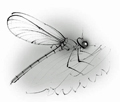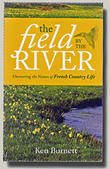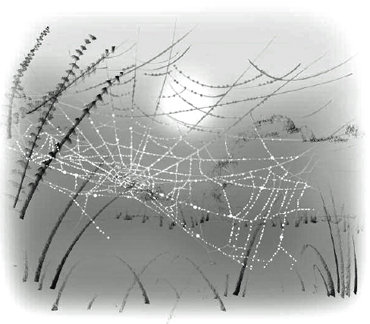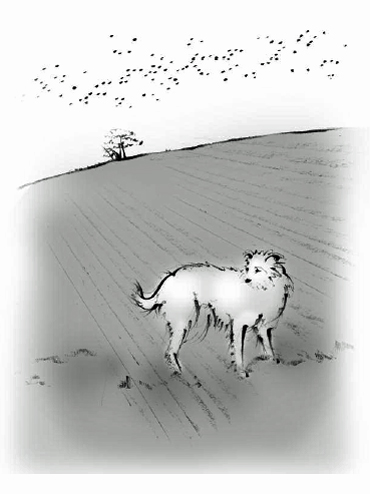| |
 Blog/book excerpt Blog/book excerpt
from
Ken Burnett, writer, publisher and occasional fundraising consultant.

These articles are reproduced from
The Field by the River by Ken Burnett, published in hardback and paperback by Anova Books Limited, London.
Now available in Kindle, download and enjoy today.
You blink.
That instant something tiny disturbs the tranquillity
of her web, perhaps a small fly or even a
big juicy grasshopper. She is upon it so quickly that the unlucky would-be passer-by can be killed, trussed, bound, packaged and suspended in the spidery larder almost before you have finished your blink.

This, of course, is hang-gliding, only they probably invented it
long before
we did.

For more about the field by the river read Rough sex down by the river, Animal intelligence, The onset of Alzheimer’s and The adventure of five white bulls.
For more on the bookThe Field by the River, click here.
 Ken Burnett can be followed by clicking the button above. Ken Burnett can be followed by clicking the button above.
For more blogs on fundraising and communication see
• Home page.
• Recent blogs.
• Archived articles.
|
|
From chapter 3, October. The deaf dumb and blind kid.
Spiders scare some people but for me they’re beyond fascinating, so I devoted several sections of my book The Field by the River to these appealing little chaps and their curious but charmingly effective ways. I like this story because, though no doubt their lives are harsh, brutal and short, it sounds as if sometimes they have great fun.

Like some great ringmaster, our spider hangs in the centre of her web, reacting by touch to the minutest sensation coming from the intricate web of fibres that radiates from the outer fringes of it right to the centre, right to the spider’s feet. Suspended from the bull’s eye the spider perches like the Who’s legendary deaf, dumb and blind kid, senses razor-sharp, playing by intuition, never missing a fall. The tiny creature’s web is football-field huge to her, the size of a soup plate for us. It is literally a dinner plate for the spider. Her varied, nutritious menu never stops being served.
Her body is apparently covered with tiny hairs, her skeleton is on the outside and her heart is to be found halfway up her back. Thanks to these minute sensory hairs on her body and legs she can detect the movement of her potential prey from the slightest change in the air currents around it. She also has chemo-sensitive hair (literally, hairs that smell), which informs her what kind of dinner has just landed on her sticky plate. Combine this with her lightning-fast reactions and who needs sight to hunt?
She can stay motionless for ages. You blink. That instant something tiny disturbs the tranquillity of her web, perhaps a small fly or even a big juicy grasshopper. She is upon it so quickly that the unlucky would-be passer-by can be killed, trussed, bound, packaged and suspended in the spidery larder almost before you have finished your blink. She paralyses her prey by injecting a venom that liquefies its insides. At this, understandably, the surprised victim stops struggling and submits to its new status, as dinner.
Then for our spider it’s back to the centre of the web and the anticipation of waiting again, suspended upside down, the perfect dining machine. Or, perhaps, the perfect food packer.
But they are short, their lives, and harsh. The smallest ones live but a few months while for the biggest and most robust it’s mostly only a year or two at best, though spiders in captivity can live a lot longer and some species, such as tarantulas, live up to twenty years.
Yet surveys of spider populations claim up to two million spiders in an acre of meadow. OK, there may be a tad fewer in the woods, but that’s still between twelve and sixteen million spiders in Kermarquer, about the human population of Cairo. Wow! But how do they count them? I’ve always marvelled at whoever it is that can count the people of Cairo, but spiders in a field . . .?

Spiders of course can’t fly, but they are very light so when they cling to a short line of silk the slightest breeze is enough to lift them aloft and carry them considerable distances.
According to spider enthusiast Stuart Bennett, some spiders have put these conditions to spectacularly good use. He calls this ‘aerial dispersal’, or ‘ballooning’. If I were a spider I think I’d call it bloody good fun.
Soft and pliable a spider’s web might be, yet it has the equivalent breaking strain of iron. Spider silk is only about 1/200th of a millimetre in diameter and is so light that if a spider could spin a strand around the world it would weigh less than six ounces. I bet there are some that could.
Ballooning, so says Mr Bennett, is most noticeable in the autumn when large numbers of spiders can be spotted ballooning together. A spider intent on ballooning climbs to a high point and turns to face the wind. Several strands of silk are expelled and these are carried up into the air. The spider then, according to Stuart, stands on tiptoe (I didn’t even know spiders had toes) and, when the force of the air currents is sufficient, they release the grip of their leg claws and awaaaaay they go.
This, of course, is hang-gliding, only they probably invented it long before we did.
From pages 102 to 106 of The Field by the River, © Ken Burnett 2009. All illustrations are by Juliet Percival.

Ken Burnett’s other books mainly focus on fundraising, communication and the wider universe. They include the classic Relationship Fundraising: a donor-based approach to the business of raising money and The Zen of Fundraising. For information on all Ken’s books, click here. To order your copy of The Field by the River, £12.99 (US$21.00) plus P&P hard cover, £7.99 (US$13.00) paperback, click here.
|
|

So close to invisible you can be in it before you know. When you realise what happens next you'll appreciate there’s good reason to cultivate the art of seeing.
 Syrus, in Loic’s field by the étang. Syrus, in Loic’s field by the étang.

Care to comment on any of this? Have your say here. Email your comment now to Ken.
|
 Blog/book excerpt
Blog/book excerpt








